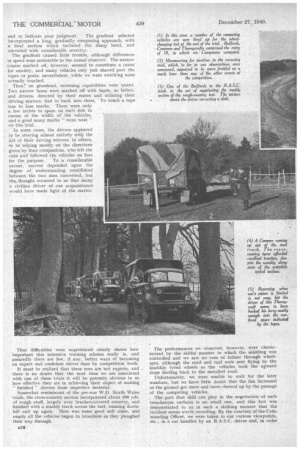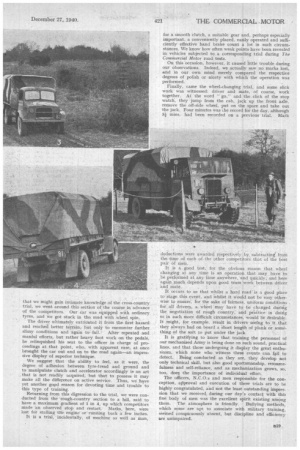Comp(
Page 24

Page 25

Page 26

Page 27

If you've noticed an error in this article please click here to report it so we can fix it.
ye Trials the "Finishing School" for RA S.C. Drivers
Weekly Trials Be by an R.A.S.C. Intensive Training the Art of Dr
Dompanies are Organized as a Means for the en in Being Masters of eavy Military Vehicles
SPORT is in British blood. The fact is largely responsible for British supremacy. Throughout the history of our race, it has been rhanifested again and again. To-day, the love of competition—of turning anything and everything into a game—is as strong as
ever. • Somewhere in the South of England (but not exclusively, of course) this characteristic is being turned to good account in the training of drivers of the R.A.S.C. It is being used as a means for encouraging efficiency and for lightening the labour of acquiring the knowledge and skill that all good Army, drivers should possess, and . the scheme is proving itself a winner.
There is no suggestion that the basic idea
is new Many operators of fleets stage contests of one form or another with comparable objects, but there is certainly Some novelty about this application of it.
Originally, this Division of the R.A.S.C. introduced competitive trials for its motorcyclists, and recently the schetne was extended to the heavy drivers. Now, a competition is held one day every week and the suecess of theplan is evidenced by the keenness of the competitors. There are no prizes. The honour and glory accruing to the Companies providing the winning teams week by week are the incentive and the satisfaction.
We were privileged, one day this December, to witness one of these trials. The entry comprised IS vehiclesBedfords, Commers and Thornycrofts—made up of six teams of. three each. All the machines were of about 87-tona capacity (Army rating) and were laden to approximately that amount. They were ordinary oneaxle-drive four-wheelers, equipped with cross-country . tyres., .Each was manned by a driver•and a. spare driver, the former' handling the machine the whole time, the latter collaborating in• •route finding, time-keeping, ,
reversing and other operations demanding joint effort.
The events comprised a map-reading contest, a hill climb, a reversing trial, the negotiation of a cross-country section, a stop and restart _test and wheel-changing against the clock. All vehicles were inspected before and after the trial, marks being deducted for any defect thus brought to light.
The map-readirig trial, or road test, consisted of a run of about 28 mileS, starting and finishing at die same point with four intermediate ,c1-iecks, so that, after being sent off on time by the starter, five subsequent timingswere taken. Vehiclessetoff at two-minute intervals, drivers' and checkers' watches all being synchronized. At the start, each driver, who was provided 'with a I-in. to the. mile map, was handed a slip with the location of the checks marked upon it, the method employed being to give a code number, for example, 674,522. This is applied to the lines corresponding with longitude and latitude, 674 meaning 6.74 spaces from west to east and 522 meaning 5.22 spaces from south to north. In addition, some landmark is defined, such as a church or a cross roads.
To locate the position indicated. (mainly the spare driver's responsibility) is not so easy, nor is the choice of route. Then to follow the correct course and to maintain the scheduled 20 m.p.h. average, particularly if the way be largely along country lanes, are by no means without difficulty.
Even a minor crash, involving nothing worse than a scratched wing, cannot be risked because of the inspection at the end. Besides the time checks, there is a distance check, and the fact that competitors have been out of their way is indicated by the mileage recorders on their vehicles.
Some of the competitors accomplished this part of the trial succesfully, finding the point and keeping to time, but others lost their way and marks as well, and the arrivals at the final check were rather irregular.
On completion of this part of the trial, drivers were dispatched to an observed test hill, culminating in a hairpin bend, bounded, for the occasion, with tapes, set sufficiently close together to compel nice negotiation
and to indicate poor judgment. The gradient selected incorporated a long, gradually steepening approach, with a final section which included the sharp bend, and ascended with considerable severity.
The gradient caused little trouble, although differences in speed were noticeable to the casual observer. The narrow course marked off, however, seemed to constitute a cause for anxiety, and many vehicles only just shaved past the tapes or posts; nevertheless, while we were watching none actually touched.
Then, on grassland, reversing capabilities were tested, Two narrow lanes were marked off with tapes, as before, and drivers, directed by their mates and utilizing their driving mirrors, had to back into them. To touch a tape was to lose marks. There were only a few inches to spare on each side in excess of the width of the vehicles, and a good many marks " went west " on this trial.
In some cases, the drivers appeared to be steering almost entirely with the aid of their driving mirrors; in oilers, to be relying mostly on the directions given by their companions, who left the cabs and followed the vehicles on foot for the purpose. To a considerable extent, success depended upon the degree of understanding established between the two men concerned, but the,, thought occurred to us that many a civilian driver of our acquaintance would have made light of the matter.
That difficulties were experienced clearly shows how important this intensive training scheme really is, and assuredly there are few, if any, better ways of becoming an expert and confident driver than by competition work.
It must be realized that these men are not experts, and there is no doubt that the next time we are associated with one of these trials it will be patently obvious to us how effective they are in achieving their object of making " finished" .drivers from imperfect material.
Somewhat reminiscent of the pre-war W.D. North Wales trials, the cross-country section incorporated about 100 yds. of rough stuff, largely over bracken-covered country, and finished with a muddy track across the turf, running downhill and up again. Here was some good soft slime, and nearly all the vehicles began to broadside as they ploughed their way through. The performances we observed, however, were characterized by the skilful manner in which the skidding was controlled and we saw no case of failure through wheelspin, although the mud and turf were sent flying by the knobbly tyred wheels as the vehicles took the upward slope leading back to the metalled road.
Unfortunately, we were unable to wait for the later numbers, but we have little doubt that the fun increased as the ground got more and 'more chewed up by the passage of the competing vehicles.
The part that skill can play in the negotiation' of such treacherous surfaces is no small one, and this fact was demonstrated to us in such a striking manner that the incident seems worth recording. By the courtesy of the Commanding Officer, we were taken to our various viewpoints, etc., in a car handled by an RA.S.C. driver aid, in order
that we might gain intimate knowledge of the cross-country trial, we went around this section of the coursein advance of the competitors. Our car was equipped with ordinary tyres, and we got stuck' in the mud with wheel spin..
The driver ultimately extricated it from the. first hazard and reached better terrain, but only to encounter further slimy conditions and again to fail. After repeated and manful efforts, but rather heavy foot work on the pedals, he relinquished his seat to the officer in charge of proceedings at that point, who, with apparent ease, at once brought the car out and on to the road again—an impressive display of superior technique.
We suggest that the ability to feel, as it were, the degree of adhesion between tyre-tread and ground and to manipulate clutch and accelerator accordingly is an art that is not readily acquired, but that to possess it may make all the difference on active service. Thus, we have yet another good reason for devoting time and trouble to this type of training.
Returning from this digression to the trial, we were conducted' from the .rough-country section to a hill, said to have a Maximum gradient of 1 in 4, up which competitors made an observed stop and restart. Marks, here, were lost.' for stalling the engineor-rUnning back a few inches.
It is a trial, incidentally, of machine as well as man. for a smooth clutch, a suitable gear and, perhaps especially important, a conveniently placed, easily operated and sufficiently effective hand brake count a lot in such circumstances. We know how often weak points have been revealed in vehicles subjected to a corresponding trial during The Commercial Motor road tests.
On this occasion, however, it caused little trouble during our observations. Indeed, we actually saw no marks lost, and in our own mind merely compared the respective degrees of polish or nicety with which the operation was performed.
Finally, came the wheel-changing trial, and some slick work was witnessed: driver and mate, of course, work together. At the word " go," and the click of the stop watch, they jump from the cab, jack up the front axle, remove the off-side wheel, put on the spare and take out the jack. Four minutes was the record for the day, although mins.had been recorded on a previous trial. Mark
.deductions were awarded respectively by subtracting. from the time of each of the other competitors that of the best
pair of then. • • It is a good test, for the obvious reason that wheel changing at any ,time is an operation that may have to be performed at any time anywhere, and quickly, and 'here again much depends upon good team 'work between driver and mate. _ :
It occurs to us that whilst a hard roadis a good place to stage this event, and :whilst it would not be easy otherwise to ensure', for the sake of fairness, uniform conditions for, all drivers, a wheel may have to be changed during the negotiation. of rough country, and pr'aetice in doing so in such, more difficult circumstances, would be desirable. It might, for example, result in drivers seeing to it that they always had on board a Short length of plank or something of the sort to put under the jack.
'It is gratifying to know that training the personnel of our mechanized Army is being done on such sound, practical lines, and that those undergoing it display the great enthusiasm, which none who witness these events can fail to detect. Being conducted as they are, they develop not only technical kill, but also good sportsmanship, resourcefulness and self-reliance, and as mechanization grows, so, too, does the importance of individual effort.
The officers, N.C.O.s and men responsible for the conception, approval and execution of these trials are to be highly congratulated, and not the least outstanding impression that we received during our day's contact with this fine body of men was the excellent spirit existing among them. The atmosphere is friendly. Bullying methods, which some areapt to associate with military training, seemed conspicuously absent, but discipline and efficiency are unimpaired.














































